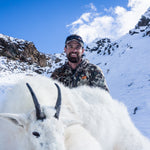The colder the better! Have you ever said that when preparing for a hunting trip? If not, maybe you should. Sure, the thought of camping in cold weather can be intimidating – especially when you’re planning a backcountry hunt. However, the arrival of cold weather can deliver some of the best hunting conditions of the year.
Cold weather can mean less pressure with fewer hunters out on the landscape. Plus, it means that animals will spend more time on their feet, rather than bedded in the timber. These factors can add up to a great hunting experience.
In fact, check out our previous article for a few tips on hunting in cold weather and why you should. And on a related note, see this previous article on why you shouldn’t overlook late season hunting opportunities.
In this article, we’ll cover tips for camping in cold weather – specifically when planning a backcountry hunt. Hunting pressure during cold weather is usually concentrated around campgrounds and established trailheads where heated campers and luxury setups make life easy. Getting into the backcountry (whether that means backpacking, or just truck-camping down a gnarly forest road that weeds out the trailers and big rigs) allows us to escape that pressure and use it to our advantage.
Backcountry hunting means you’ll be much more limited by weight and space. But if you’re willing to brave the cold in a tent, you might find some of the best hunting of the year.
Here are a few tips to help you along the way…
CLOTHING
Staying comfortable on a cold weather camping trip starts with a quality clothing system and the right items in your clothing arsenal. As we’ve said before, you don’t need to buy into the notion that fancy-schmancy hunting gear will somehow make you a better hunter. However, insofar as it keeps you on the mountain in tough conditions – then it does increase your chances at success.
For years we've trusted Sitka Gear layering systems, built for mountain hunters. From our hunts here in Colorado, to Alaska and everywhere in between, we can be confident knowing that we'll stay dry, stay comfortable and stay in the game, no matter the weather.
When packing for a backcountry hunt, focus on layers that are versatile and lightweight for their warmth. Think merino wool or quality synthetic base layers, fleece and goose down mid-layers, along with waterproof/breathable outerwear.

On a typical cold weather backcountry hunt, here’s a basic layering system to consider:
Base Layers
Look for thermal merino wool or high quality synthetic base layers. Pack at least two shirts, a mid-weight and a heavy weight option. These can be layered together or worn individually as temperatures change throughout the hunt and even throughout the day. Also pack at least one set of long underwear bottoms. If weight and space allow, a mid-weight and a heavy-weight option can be nice.
Along with the base layer top and bottoms, pack high quality merino wool socks and underwear. Cotton doesn’t have any place on a backcountry hunt. Bring enough socks to have a dry pair for each day of the hunt. Keep one spare set of socks in a ziplock baggie in your daypack while you hunt. If the ones you're wearing get wet - or even if your feet get sweaty - changing into a dry pair of socks can be a game changer. If that's the difference between going back to camp early and staying out past dark, you're putting yourself in a position for success.
Additionally, bring at least one warm beanie and multiple sets of gloves. If one gets wet, it’s critical to have backup.
Insulating Layers
Next, pack warm and lightweight insulating layers. Consider a warm pair of hunting pants on the bottom, plus fleece and high quality goose down jackets on top. These items weigh very little for the amount of warmth they provide.
On a typical rifle season hunt, I’ll wear quarter-zip fleece over my base-layer tops. Layered over that will be a puffy down jacket, vest, (or both) depending on conditions.
Over my long-underwear bottoms, I’ll wear a pair of quality hunting pants - one with waterproof seat and knees like the Sitka Timberline is ideal. If conditions are very cold, I’ll add a pair of puffy pants for glassing in the mornings and evenings and just for hanging out at camp.
Outerwear
One of the most critical pieces of a layering system is high quality rain gear. Even if there’s no precipitation in the forecast, my hardshell jacket and pants go with me on every cold weather hunt. The waterproof, breathable membrane is also totally windproof. In fact, did you know that the only difference between “Windstopper” and Gore-Tex rain gear is taped seams? You don’t need to pack an extra wind-blocking layer for these late season hunts if you have quality rain gear.
When layered over the top of your base layers and insulating layers, a rain jacket and pants will block the wind, keeping you dry and comfortable. This is especially helpful when sitting stationary and glassing for long periods.
Footwear
Hunting in cold weather requires good boots, socks and gaiters. If your feet tend to run cold, this is especially important. Instead of heading back to camp to warm up your toes, you should be out in the field, upping your odds of success.
We recommend high quality, full-grain leather insulated boots like the Kenetrek Mountain Extreme. When paired with high quality merino socks and gaiters, you’ll be able to hunt all day in comfort. Just remember how important it is to avoid wearing cotton in the backcountry. Even a great pair of boots won’t be comfortable if you’re wearing cotton socks.

SHELTER
Your choice of shelter style makes a big difference in cold weather. A good three-season tent is just fine in mild fall weather. But it won’t hold up in heavy snow and the condensation will turn many tents into little ice shelters when the temps really plunge.
If you’re camping at the truck, a wall tent with a wood stove or propane heater is nice. But when weight and space are at a premium on backcountry hunts, using a tipi style tent with a packable titanium wood stove is an excellent option. Innovative designs from companies like Seek Outside are lightweight, and very packable. Having a warm and spacious tent in the backcountry makes camping in winter conditions a lot more fun.
If your budget doesn’t allow you to spring for an ultralight hot tent this year, know that you can still camp in a traditional backpacking tent in cold weather. A good four-season tent will hold up to wind and snow. Just be aware that in these situations, a high quality system is even more important…

SLEEP SYSTEM
Again, if you’re camping at the truck and you have space, don’t hold back on blankets and sleeping bags. You can nest extra quilts and blankets below and on top of your sleeping bag for extra insulation. If you’re backpacking or if space is limited, you can still stay plenty warm with a high quality sleep system.
Sleeping Pad
The foundation of your system is a good, insulated air mattress. Whether you’re sleeping on the ground or on a cot, the trapped air in your insulated mattress will keep you much warmer than if you were sleeping on a foam pad.
Look for a mattress with a high R-value rating. R-value is the sleeping pad equivalent of the temperature rating on a sleeping bag. A good example of a lightweight, backcountry air mattress with a high R-value is the Thermarest NeoAir XTherm.
When it comes to sleep systems, it’s easy to focus all your attention on the sleeping bag. And yes, a high quality sleeping bag is important. But especially when camping in cold weather, your pad is critical. There will be a significant difference if you pair your sleeping bag with an insulated air mattress.
Sleeping Bag
Next, you’ll want a high quality goose down sleeping bag. Quality goose down offers the best warmth-to-weight ratio of any insulation. Look for sleeping bags with at least 800-fill down. That fill rating number tells you the quality of the down. For example, a sleeping bag with 600-fill down will be significantly bulkier and heavier than a bag with 800-fill down. The higher the number, the fewer feathers it takes to achieve the same loft and warmth.
On cold weather hunts, a zero-degree sleeping bag is ideal. If needed, you can even wear your puffy jacket, pants and base layers to bed. This will significantly increase the temperature rating of your sleeping bag. Just don’t do anything to compress the down in your bag, as that would reduce its effectiveness.
IN THE EVENINGS
When hunting and camping in cold weather, it helps to take care of a few chores in the evenings when you get back to camp. This time of year, it gets dark relatively early, so you’ll have plenty of time to get things organized in the evenings. Plus, this saves you from getting things ready in the bitter cold mornings.
Every evening at camp, take the time to refill your water bottles for the next day’s hunt. While you’re at it, pack your lunch and all your snacks for the next day. Before you go to bed, your daypack should be loaded and ready to go.
When the weather is extremely cold, boil some water right before you go to bed and fill one or two Nalgene bottles. Tighten the lids and wrap them in an extra shirt or socks. Throw one in the foot of your sleeping bag and keep another near your chest to warm the core. This heat system will last throughout the night, keeping you comfortable in cold conditions without burning through your fuel.
When you go to bed, keep your clothing for the next day in your sleeping bag as well. This will keep them warm. Few things are more uncomfortable than putting on freezing cold clothes in the morning.
Remember that cold temperatures can also zap batteries. With that in mind, it can be a good idea to stash your phone and headlamp in your sleeping bag. If you have camera batteries, GPS and other bulky items that don’t comfortably fit at the bottom of your bag, you can roll them up in an extra jacket and keep them next to you in the tent.

IN THE MORNINGS
Having loaded your daypack the night before with water, snacks and lunch, you can quickly get dressed put on your backpack and get moving to warm up. We recommend eating breakfast later – there’s no need to spend any more time standing around camp in the freezing pre-dawn darkness.
Instead of making breakfast before you leave camp, pack some instant coffee and your Jetboil stove system in your daypack. Put on your backpack and get moving to warm up. Get to your spot and spend those prime, early daylight hours glassing and hunting. Once the sun begins to warm things up, get out your stove and make a hot cup of coffee and eat a little breakfast. It’s much more pleasant eating breakfast out on the mountain with the morning sunshine on your shoulders.
Along with your lunch and snacks for the day, bring extra instant coffee or some tea. Later in the day if you’ve been glassing for hours or if you just need a little warm-up, a hot cup of coffee or tea can make all the difference.
CONTACT US WITH QUESTIONS
If you have questions about hunting gear or cold weather camping, please feel free to ask.

By Ryan McSparran & Zach Lazzari














